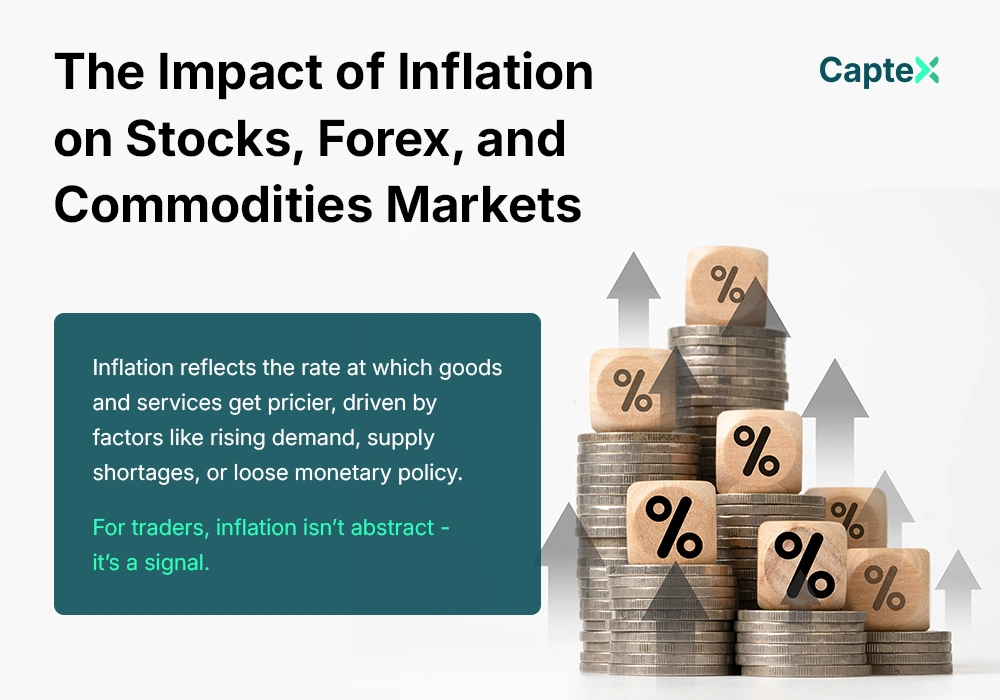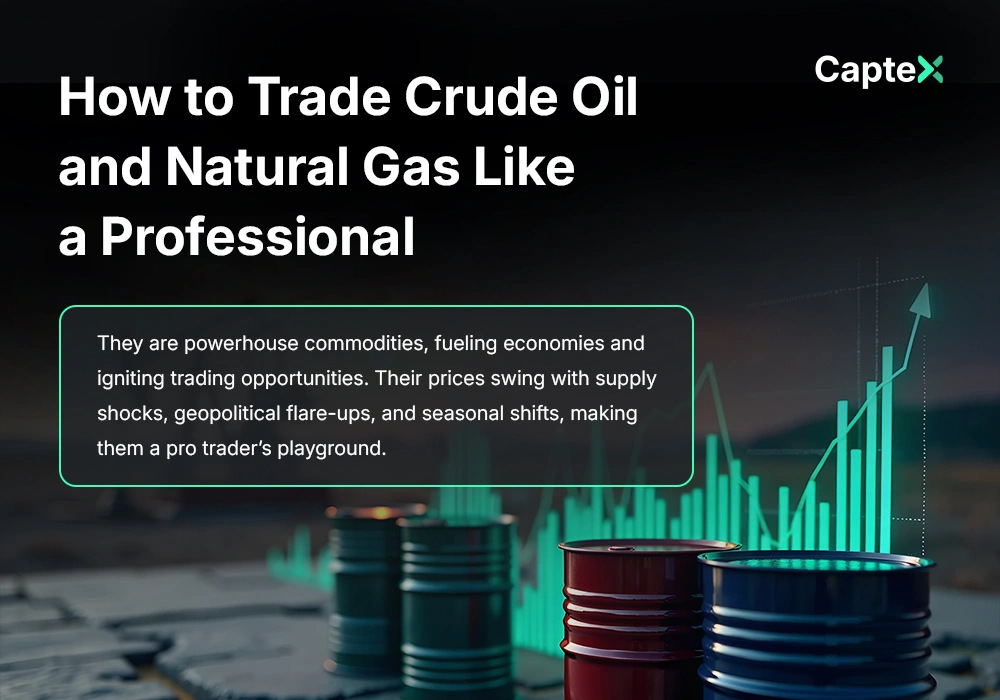Inflation—the steady rise in prices over time—shapes financial markets in profound ways, influencing stocks, forex, and commodities with both challenges and opportunities. As purchasing power erodes, investors adjust strategies to protect wealth or capitalize on shifts. Understanding inflation’s effects across these asset classes is crucial for traders aiming to stay ahead. Let’s dive into how inflation ripples through stocks, forex, and commodities, and how to navigate its waves.

What Is Inflation and How Is It Measured?
Inflation reflects the rate at which goods and services get pricier, driven by factors like rising demand, supply shortages, or loose monetary policy. Central banks track it via indices like the Consumer Price Index (CPI) or Producer Price Index (PPI). A CPI jump from 2% to 4% signals hotter inflation, prompting market reactions—higher yields, weaker currencies, or commodity spikes.
For traders, inflation isn’t abstract—it’s a signal. Moderate levels (1-3%) fuel growth; runaway rates (above 5%) spark uncertainty. Core inflation—stripping out volatile food and energy—offers a cleaner read. Watch monthly reports; a surprise uptick can jolt all three markets in hours.
Inflation’s Effect on Stock Markets
Stocks feel inflation’s heat differently across sectors. Moderate inflation often lifts equities—companies pass costs to consumers, boosting revenue. Growth stocks—like tech—thrive as cheap money flows, pushing indices higher. But when inflation surges, central banks hike rates, raising borrowing costs and crimping profits. Value stocks—think utilities or consumer staples—hold up better, as they lean on steady demand.
High inflation erodes future cash flows’ value, tanking high-valuation stocks first. A 10-year Treasury yield climbing past 3% might signal a sell-off in growth-heavy sectors. Traders pivot to inflation-resistant firms—those with pricing power or low debt—while eyeing rate-sensitive names to short.
Inflation and Corporate Earnings
Earnings take center stage as inflation bites. Rising input costs—labor, materials—squeeze margins unless firms raise prices. Big players with strong brands often succeed, passing hikes to buyers without losing sales. Smaller firms struggle, facing higher debt costs or weaker demand, denting profits.
Look at earnings reports—revenue growth beating inflation hints at resilience; shrinking margins flag weakness. A CPI spike to 6% might lift a retailer’s stock if sales hold, but tank a manufacturer if costs soar unchecked. Pros scan guidance for inflation clues, betting on winners and fading losers.
Factors showing earnings strength:
- Consistent revenue outpacing inflation rates.
- High gross margins despite cost pressures.
- Strong pricing power in competitive markets.
- Low debt levels reducing rate hike pain.
- Diversified supply chains dodging shortages.
How Inflation Influences Forex Markets
Inflation rewires forex by shifting currency strength. High inflation weakens a currency—think USD dropping as U.S. CPI soars—since purchasing power fades. Central banks counter with rate hikes, drawing capital and lifting the currency back. EUR/USD might fall if the Fed tightens faster than the ECB, reflecting rate differentials.
Low inflation or deflation boosts currencies like Japan’s yen (JPY), a safe-haven play. Carry trades flip—borrow cheap JPY, buy high-yield AUD—until inflation gaps widen. Watch CPI, PPI, and central bank rhetoric; a hawkish shift (rate hikes looming) can swing pairs like USD/JPY in a day.
Inflation’s Role in Currency Valuation
Currency value ties to inflation expectations. If U.S. inflation hits 5% while Europe’s lags at 2%, USD weakens—EUR/USD climbs as euro gains appeal. Real interest rates (nominal rates minus inflation) matter too; negative real yields tank a currency, positive ones lift it. A Fed rate at 3% with 4% inflation signals weakness; 3% with 1% inflation screams strength.
Traders track bond yields—rising 2-year yields signal rate bets, moving forex fast. Inflation differentials between nations drive long-term pair trends. A surprise CPI beat can flip USD/CAD if Canada’s inflation lags, making data releases prime trading triggers.

Commodities as an Inflation Hedge
Commodities shine when inflation heats up. Hard assets—oil, gold, copper—rise as fiat money loses value. Gold, a classic hedge, jumps during high inflation—XAU/USD might rally from $1,800 to $2,000 as CPI climbs. Oil tracks demand and input costs—a 5% inflation rate lifts WTI if growth holds. Soft commodities—wheat, corn—soar with supply shocks or weather woes.
Not all win equally. Gold lags in moderate inflation if yields rise; industrial metals like copper need growth to shine. Pros buy dips in commodity futures or ETFs when inflation ticks up, betting on tangible value over paper erosion.
Commodity inflation winners:
- Gold for wealth preservation in crises.
- Oil tied to energy demand and costs.
- Copper reflecting industrial growth.
- Agricultural goods riding supply squeezes.
- Silver blending safe-haven and industrial roles.
Precious Metals During High Inflation
Gold and silver thrive as inflation hedges, but with twists. Gold surges when real yields turn negative—say, 2% rates with 3% inflation—since it beats cash. A 1970s-style stagflation (high inflation, low growth) could push gold past $2,500. Silver, with industrial demand, outpaces gold in growth-driven inflation, jumping 20% to gold’s 10%.
High rates can cap gains—gold hates competition from bonds. Watch Fed signals; a dovish stance (low rates despite inflation) fuels XAU/USD, while hawkish hikes dent it. Silver’s volatility demands tighter stops, but its upside lures aggressive traders.
Inflation Expectations and Market Sentiment
Markets don’t wait for inflation—they trade expectations. A rising breakeven rate (10-year Treasury minus TIPS yield) signals bets on higher prices, lifting commodities and forex volatility. Stocks wobble if rate hikes loom; forex pairs like AUD/USD climb if inflation favors commodity currencies.
Sentiment shifts fast—hot CPI data sparks panic, cooling numbers ease fears. Pros use inflation swaps or bond spreads to gauge mood, pairing with technicals like RSI to time entries. A mispriced expectation—like underestimating a rate hike—creates gaps to exploit.
Trading Strategies for Inflationary Environments
Inflation calls for tailored plays. In stocks, buy firms with pricing power—consumer staples or energy—shorting rate-sensitive tech during hikes. Forex traders go long commodity currencies (CAD, AUD) against USD when inflation lifts oil or metals. Commodities shine—buy gold futures on CPI beats, oil on supply fears.
Hedge with diversification—stocks for growth, gold for safety, forex for currency plays. Use options—a crude call limits risk—or stops at 2% loss caps. Backtest against past inflation spikes (e.g., 2021-22) to refine timing. Flexibility beats rigidity when inflation stirs.
Navigating Uncertainty with Inflation Data
Data drives decisions—CPI, PPI, PCE releases move markets instantly. A U.S. CPI jump from 3% to 4% might tank USD/JPY as yen gains, lift XAU/USD, and mixed-bag stocks. Pros prep levels—support at $80 for WTI, resistance at $1,900 for gold—striking post-release.
Economic calendars flag dates; pair with Fed minutes or ECB speeches for context. Unexpected beats or misses magnify moves—trade the breakout, not the rumor. Volatility spikes, so scale positions and lean on fundamentals to filter noise.
Bottom Line
Inflation weaves a complex web across stocks, forex, and commodities, rewarding those who decode it. Stocks split by sector resilience, forex dances with rate expectations, and commodities rise as hedges. Traders win by blending data—CPI, yields, earnings—with strategy, pivoting from growth bets to safe plays as inflation shifts. It’s not just a number; it’s a market mover. Stay sharp, adapt fast, and let inflation guide your next trade.




